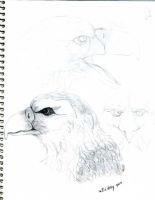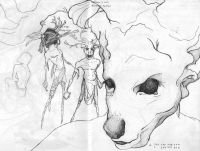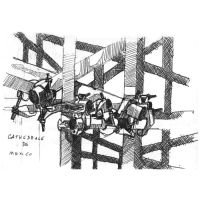Why Art Descriptions Matter to Collectors
Understanding how to write compelling art descriptions that attract collectors is a skill that bridges the gap between visual storytelling and emotional connection. While your artwork speaks for itself, the description offers collectors a deeper entry point—a place to connect to the meaning, mood, and materials of your work. A well-crafted description elevates the perceived value of your art and invites potential buyers to emotionally invest.

credit: muffy820
Why Art Descriptions Are Crucial:
[ ARTWORK ] <— Visual Appeal
↓
[ DESCRIPTION ] <— Deeper Entry Point (Meaning, Mood, Materials)
|
↓
[ COLLECTOR ] <— Emotional Investment & Purchase
— BENEFITS —
* Strengthens online sales (storytelling)
* Improves SEO (search visibility)
* Helps galleries/curators (intent)
* Fosters emotional resonance (audience)
Let’s explore how to write meaningful, authentic, and strategic descriptions that not only showcase your work but also drive engagement and sales.
Art collectors often seek more than just visual appeal—they’re looking for significance, voice, and narrative. A clear and descriptive artwork summary allows them to better understand the artist’s vision, context, and technique. Done well, this written complement creates intimacy and reinforces your brand identity as a thoughtful, intentional creator.
Strong descriptions also play a vital role in:
- Strengthening online sales through product storytelling
- Improving search engine visibility via art description SEO
- Helping galleries and curators understand your intent
- Fostering emotional resonance with your audience
Key Elements of a Compelling Art Description
While every artist’s voice is different, a great description typically includes the following elements:
Title and Medium
Always start by stating the title of the piece and the materials used. Include dimensions and year, as these details create a framework for understanding the work’s physicality.
Example: “Echoes in Blue,” acrylic and pencil on wood panel, 20” x 30”, 2024
Concept or Theme
What inspired this piece? Is there a recurring motif in your work? A clear concept helps collectors understand the emotional or intellectual significance behind the piece.
Mood or Emotion
Consider the emotional tone of the work. Is it contemplative, vibrant, melancholic, or meditative? Use sensory language to evoke atmosphere. This builds a bridge between the viewer’s intuition and your message.
Technique and Process
Mention specific techniques, layering methods, or tools used. Describe how these choices affect the final piece. Phrases like creative process, mixed media techniques, and textural details help search engines and viewers alike understand your craftsmanship.
Story or Personal Reflection
If applicable, add a short anecdote about what this piece means to you or what inspired it personally. Stories humanize your work and make it easier for potential collectors to emotionally engage.
Key Elements of a Compelling Art Description:
1. TITLE & MEDIUM:
* What: Title, materials, dimensions, year.
* Example: “Echoes in Blue,” acrylic, 20″x30″, 2024.
2. CONCEPT or THEME:
* What: Inspiration, recurring motifs, emotional/intellectual significance.
* For SEO: “art inspiration,” “conceptual artwork.”
3. MOOD or EMOTION:
* What: Tone (contemplative, vibrant, melancholic).
* How: Use sensory language to evoke atmosphere.
4. TECHNIQUE & PROCESS:
* What: Specific methods, layering, tools used.
* For SEO: “creative process,” “mixed media techniques.”
5. STORY or PERSONAL REFLECTION:
* What: Anecdote about inspiration or personal meaning.
* Why: Humanizes work, builds emotional engagement.
Tips for Writing in a Collector-Friendly Voice
Use Plain Language with Poetic Touches
Avoid overly technical jargon. Instead, write as if speaking to an informed but non-expert art lover. Use metaphor or creative description sparingly to add color without confusion.
Example:
Instead of “This piece explores the juxtaposition of selfhood through disparate modalities,”
Try “This painting reflects the quiet tension between strength and softness, a mirror of personal transformation.”
Keep It Concise Yet Evocative
Aim for 100–150 words per piece. Too little text leaves questions unanswered; too much may overwhelm. Stay focused on what a collector needs to know to understand and appreciate the work.
Speak in the Present Tense
Describe the piece and your thoughts in the now. This gives the description immediacy and presence, enhancing its connection.
Include Practical Information
Along with title and medium, mention framing, surface type (canvas, wood, paper), and if it’s ready to hang.
Optimize Your Descriptions for Online Discovery
To attract more collectors organically, your art descriptions should also be search-friendly. Here’s how:
- Use your focus keyword and related LSI phrases naturally throughout your description and page content.
- Add alt text for your images that reflects the title, medium, and mood.
- Use structured metadata like artwork title, materials, size, and year in your backend.
- Use internal links to connect similar pieces or themed collections.
Including terms like fine art prints, emerging artist, limited edition artwork, and collector’s favorite can further strengthen organic search traction.
Optimizing for Online Discovery (SEO):
1. KEYWORDS:
* Use focus keyword + LSI (Latent Semantic Indexing) phrases naturally.
* Examples: “fine art prints,” “emerging artist.”
2. ALT TEXT for IMAGES:
* Reflect title, medium, mood in image descriptions.
3. STRUCTURED METADATA:
* Input artwork title, materials, size, year in backend.
4. INTERNAL LINKS:
* Connect similar pieces or themed collections within your site.
Sample Art Description
“Awakening” is a 16″x20″ mixed media painting on wood, created with acrylic, graphite, and layered collage. Inspired by early morning walks through fog-filled landscapes, the piece captures the moment where memory and mood intersect. Pale gray textures rise like mist from earth-toned edges, softened by translucent shapes that fade and reappear. As light cracks across the top layer, a quiet momentum unfolds—a visual meditation on renewal.
This sample balances emotion, narrative, and technical description to invite exploration.
Sample Art Description Breakdown:
“Awakening” <– [TITLE]
is a 16″x20″ mixed media painting on wood, created with acrylic,
graphite, and layered collage. <– [DIMENSIONS, MEDIUM, TECHNIQUE]
Inspired by early morning walks through fog-filled landscapes, the piece
captures the moment where memory and mood intersect. <– [CONCEPT/INSPIRATION]
Pale gray textures rise like mist from earth-toned edges, softened by
translucent shapes that fade and reappear. <– [MOOD/EMOTION, TECHNIQUE]
As light cracks across the top layer, a quiet momentum unfolds—a visual
meditation on renewal. <– [STORY/REFLECTION, MOOD]

Sketchbooks.org | ARTIST MARKETING GUIDE
How to Build an Artist Brand | That Feels Authentic and True to You
What Is an Artist Brand, Really? Understanding how to build an artist brand that feels authentic is one of the most transformative steps in becoming not only visible—but memorable—in today’s creative landscape. Your brand is...
Frequently Asked Questions
How long should an art description be?
Around 100–150 words is ideal for keeping collectors informed without overwhelming them.
Should I describe each piece individually or write one for the series?
Both—series-level context is helpful, but each piece deserves its own voice.
Can I reuse parts of descriptions for similar works?
Yes, but personalize details and emotional tone so each piece feels distinct.
Do collectors really read descriptions?
Absolutely—descriptions often influence purchase decisions, especially online.
Should I include pricing or availability in the description?
If posted on an e-commerce page, yes; otherwise, link or guide visitors to purchase information.
Should I use poetic or narrative writing?
Yes, but keep it balanced—make sure it enhances clarity rather than clouding your intent.
Is it okay to write in first person?
Yes, especially if you’re selling directly. It adds a sense of intimacy and authenticity.
Should I add tags or hashtags to art descriptions?
Tags belong in metadata or on social platforms, not in the main description—keep it clean and focused.
Final Thoughts
Learning how to write compelling art descriptions that attract collectors is a practice in storytelling and presentation. A strong description isn’t just a text box to fill—it’s a chance to contextualize, enchant, and connect. It helps collectors see not only what the piece looks like, but what it feels like, what it means, and why it matters.
When your descriptions reflect the same care and clarity as your artwork, they become part of the artistic experience—and that’s what turns interest into lasting connection.

credit: simplysticky
Ready to Share Your Work?











I always thought the image was enough
authenticity over art-speak
I try to write descriptions like I’m walking someone through the piece at a gallery.